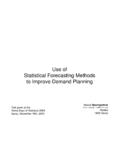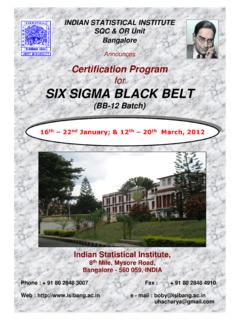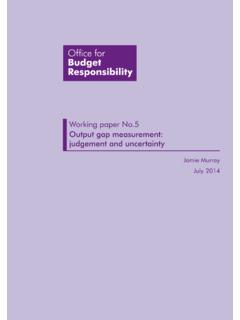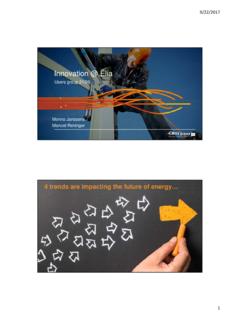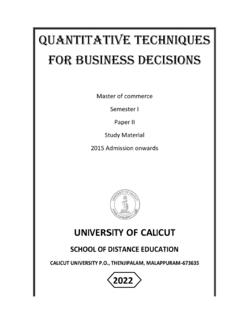Transcription of CALCULATION OF COMPOSITE LEADING …
1 CALCULATION OF COMPOSITE LEADING INDICATORS:A COMPARISON OF TWO DIFFERENT METHODSP aper for presentation at the CIRET Conference inParis, 10-14 OctoberbyOlivier Brunet, OECD SecretariatKeywords: COMPOSITE LEADING indicator - Trend Estimation - Phase-Average Trend Method - DataTransformation - Detrending - Ratio to Trend - Normalisation - Level Data - First Difference Data -Balance Data - Business Tendency SurveysOlivier BrunetOECD SecretariatParis, Macroeconomic Analysis andForecasting B (CLI) 3 PRESENTATION OF THE 3 ESTIMATION OF THE TREND: PRESENTATION OF THE TWO methods .
2 4 PHASE-AVERAGE TREND (PAT).. 4 PERIOD TO PERIOD CHANGES (PPC) ..5 SMOOTHING .. 5 NORMALISATION: PRESENTATION OF THE TWO methods .. 6 NORMALISATION OF PHASE-AVERAGE TREND SERIES (NPT) .. 6 NORMALISATION OF PERIOD TO PERIOD CHANGES SERIES (NPP).. 7 COUNTRY RESULTS .. 10 CONCLUSIONS .. 11 BIBLIOGRAPHY .. 123 IntroductionThis study compares the German and the Japanese COMPOSITE LEADING indicators using twomethods of trend estimation and two methods of data normalisation. These two COMPOSITE indicators havebeen selected in order to show that the nature of the component series is important in choosing thecalculation method of a COMPOSITE LEADING indicator of the first country, Germany, is composed mainly of series from business tendencysurveys (qualitative series).
3 For the second country, Japan, the indicator is based mainly on series in levelform (quantitative statistical series).Presentation of the indicatorsSixty-six percent of the German COMPOSITE LEADING indicator is composed of business tendencysurveys series: Order books: level, Order inflow of flow demand: tendency, Business climate indicator andFinished goods stocks: level. The two other component series are Share prices and Total new study is conducted on data from January 1964 to June 2000 in order to compile thecomposite LEADING indicator with all data figures available for all component series for the whole series are seasonally 1 Component series of the German CLIS tarting dateEnding dateQualitative seriesStock finished goods: levelJanuary 1959 June 2000 Order books: levelJanuary 1963 June 2000 Orders inflow: tendencyJanuary 1960 June 2000 Business climate.
4 CurrentJanuary 1961 June 2000 Quantitative seriesNet new ordersJanuary 1962 June 2000 Share pricesJanuary 1960 July 2000 The German COMPOSITE LEADING indicator is very much restricted to components related to activityin the industrial sector of the economy. Out of the six components four refer to industrial activity asmeasured by the business survey in industry. The remaining two components refer to a volume series onnew orders and the share price Japanese COMPOSITE LEADING indicator only contains of two business tendency surveys series:Finished goods stocks: level and Business situation: prospects.
5 The rest of the series (77%) are series inlevel form and include: Producer inventory ratio to shipment, Excess of imports over exports, Total stocksin manufacturing, New loans for equipment (commercial banks), Ratio loans to deposits, Share pricesTokyo stock exchange and New study is conducted from January 1974 to April 2000 in order to compile the compositeleading indicator with all data available for all component series for the whole period. From April 1998,the Japanese COMPOSITE LEADING indicator is only calculated using eight components because the series Newloans for equipment is only available until March 1998.
6 All series are seasonally 2 Component series of the Japanese CLIS tarting dateEnding dateQualitative seriesBusiness climate: future tendency2nd Quarter 19672nd Quarter 2000 Stock finished goods: level1st Quarter 19632nd Quarter 2000 Quantitative seriesInventory shipment ratioJanuary 1955 May 2000 Total stocks in manufacturingJanuary 1955 April 2000 New vacanciesJanuary 1957 June 2000 Share pricesJanuary 1959 June 2000 New loans for equipmentJanuary 1955 March 1998 Ratio loans to depositsJanuary 1955 May 2000 Excess of imports over exportsJanuary 1973 June 2000 Estimation of the trend: presentation of the two methodsPhase-Average Trend (PAT)This first method estimates a trend in a direct way and removes it from the series.
7 For the trendestimation, we use the Phase-Average Trend first consideration in the construction of a COMPOSITE cyclical indicator is that of amplitude-stationarity. The first objective is to ensure that each individual indicator series included in the compositeindicator is stationary in some way. The "growth cycle" or "deviation-from-trend" approach is used. Trendestimation is thus a crucial step in detecting cyclical movements and identifying turning PAT method requires an initial list of turning points, which define the cyclical phases, inorder to estimate a trend which cuts through the phases.
8 A first list of turning points is obtained from thepreliminary peaks and troughs identified by calculating a first trend estimate based on a 75-month moving-average. A series of tests are then executed on the deviations from the trend in order to eliminate extremevalues; and to specify a minimum duration of each phase (5 months) and the minimum duration of eachcycle (15 months). The final trend is then calculated with a validated list of turning points as input to thePAT program. The detrended results (deviations from long-term trend) are then used as input to thecomposite to Period Changes (PPC)This second method removes the trend by transformation of data to stationary form by applyingthe period to period changes to data.
9 This method has been applied to all quantitative series:2)(11 + =tttttXXXXS with:S : Period to period changes seriesX : Quantitative seriest : TimeConcerning the qualitative tendency business survey series, it is not necessary to apply the periodto period changes or first difference method to this kind of series because data are first differences bynature. For business tendency surveys series, data fluctuate over a level which is a constant figure andtherefore series do not have a trend. The balance the difference between positive and negative answersis used for the business tendency survey the normalisation stage, we need to smooth both the quantitative series and the period toperiod change series.
10 The method of smoothing is explained as follows:It is necessary to ensure that all component series have equal smoothness . This is to ensure thatperiod-to-period changes in the COMPOSITE indicator are not unduly influenced by irregular movements inany one indicator series. The "Months for Cyclical Dominance" (MCD) moving average is used. Thisprocedure ensures approximately equal smoothness between series and also ensures that the period-to-period changes in each series are more likely to be due to cyclical than to irregular movements. The datalost at the end of the series due to the moving average are restored with an extrapolation by regression overthe end of the MCD values for most series across investigated countries are in the range 1-3.










